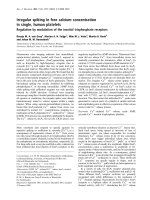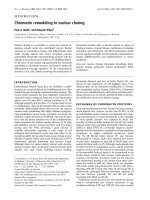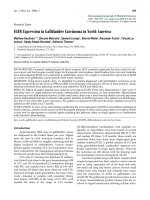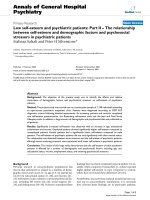Báo cáo y học: " Antipolymer antibody in Italian fibromyalgic patients" docx
Bạn đang xem bản rút gọn của tài liệu. Xem và tải ngay bản đầy đủ của tài liệu tại đây (181.9 KB, 5 trang )
Open Access
Available online />Page 1 of 5
(page number not for citation purposes)
Vol 9 No 5
Research article
Antipolymer antibody in Italian fibromyalgic patients
Laura Bazzichi
1
, Camillo Giacomelli
2
, Francesca De Feo
1
, Tiziana Giuliano
1
, Alessandra Rossi
2
,
Marica Doveri
1
, Chiara Tani
1
, Russell B Wilson
3
and Stefano Bombardieri
1
1
Department of Internal Medicine, Division of Rheumatology, University of Pisa, Pisa, Italy
2
Department of Psychiatry, Neurobiology, Pharmacology and Biotechnology, University of Pisa, Pisa, Italy
3
Autoimmune Technologies, L.L.C. 1010 Commons Suite 1705, New Orleans, LA 70112, USA
Corresponding author: Laura Bazzichi,
Received: 21 May 2007 Revisions requested: 10 Jul 2007 Revisions received: 27 Jul 2007 Accepted: 6 Sep 2007 Published: 6 Sep 2007
Arthritis Research & Therapy 2007, 9:R86 (doi:10.1186/ar2285)
This article is online at: />© 2007 Bazzichi et al.; licensee BioMed Central Ltd.
This is an Open Access article distributed under the terms of the Creative Commons Attribution License ( />2.0), which permits unrestricted use, distribution, and reproduction in any medium, provided the original work is properly cited.
Abstract
The objectives of the present study were to evaluate the
presence of antipolymer antibody (APA) seropositivity in 285
Italian patients affected by primary fibromyalgia (FM) and to
verify whether APA levels correlate with disease severity and
with cytokine levels.
APA levels were determined on serum samples by an indirect
ELISA kit that detects IgG APA. Cytokines (IL-1, IL-6, IL-8, IL-10
and TNFα) were measured by ELISA in plasma. The impact of
FM on the quality of life was estimated using the Fibromyalgia
Impact Questionnaire, while pain severity was evaluated using a
visual analogic scale. Patients were also characterized by the
presence of tiredness, stiffness, nonrestorative sleep, anxiety,
depression, tension headache, irritable bowel syndrome,
temporomandibular dysfunction and Raynaud's phenomena.
Using a cut-off value of 30 U, APA-positive values were
detected in 60 FM patients (21.05%) and in 15 healthy control
individuals (15.00%) without significant differences among their
levels or the percentage of seropositivity. FM patients with
moderate and severe symptoms had slightly higher APA levels
with respect to patients with mild symptoms. APA-seropositive
patients exhibited significant correlations between APA levels
and the Fibromyalgia Impact Questionnaire estimate (P =
0.042), tiredness (P = 0.003) and IL-1 levels (P = 0.0072).
In conclusion, APA cannot be considered a marker of disease in
Italian FM patients. The presence of APA, however, might permit
the identification of a subset of FM patients with more severe
symptoms and of patients who may respond differently to
different therapeutic strategies.
Introduction
Fibromyalgia (FM) is a syndrome defined by widespread pain
for longer than 3 months and by the presence of ≥11 of 18 ten-
der points [1]. Most FM patients report fatigue, disrupted or
nonrestorative sleep, mood disturbances, exercise-induced
symptom flares and multiple other syndromes (for example,
restless leg syndrome, irritable bowel syndrome and chronic
headaches) [1-3]. Physical and emotional health as well as
quality of life is often seriously impaired [4-6]. Women are the
most affected (9:1 ratio of women to men affected). Like many
other clinical syndromes, FM has no single specific feature but
represents a complex of symptoms of self-reported or clinical
deduction. Unfortunately, there is still no standardized labora-
tory test to detect FM or to measure its severity.
Researchers have suggested that many of the symptoms
reported by women with silicone gel-filled breast implants
appear to be similar to those observed in patients with FM [7].
Tenenbaum and colleagues [8] reported that many silicone
breast implant recipients produced serum antibodies that rec-
ognized what initially appeared to be a high-molecular-weight
antigen. After further characterization, it was determined that
this antigen was not a protein, but a complex composed of par-
tially polymerized acrylamide. Because of the polymer nature
of the antigen, these antibodies have been named antipolymer
antibodies (APAs).
Because of the suggested similarities between FM and
reported symptoms by patients with silicone gel-filled breast
implants, one of us examined the association of APA and FM
and found that 47% of patients in a general rheumatological
APA = antipolymer antibody; ELISA = enzyme-linked immunosorbent assay; FM = fibromyalgia; IL = interleukin; TNF = tumour necrosis factor.
Arthritis Research & Therapy Vol 9 No 5 Bazzichi et al.
Page 2 of 5
(page number not for citation purposes)
setting in the United States were seropositive for the presence
of APA [9]. Consequently, other researchers began to investi-
gate the APA seroactivity in patients with FM, finding contro-
versial data [10,11].
In light of these results, we examined the APA levels in a
cohort of Italian FM patients and investigated their association
with disease severity and cytokine levels. To determine
whether APA results from a generalized autoimmune
response, the APA seroreactivity was evaluated also in several
autoimmune disease noncase groups including rheumatoid
arthritis, Sjögren's syndrome, systemic sclerosis, systemic
lupus erythematosus and undifferentiated connective-tissue
disease.
Materials and methods
Patients
We recruited 285 consecutive patients (270 females, 15
males) affected by primary FM as assessed by the 1990 Amer-
ican College of Rheumatology criteria [12], 40 noncase indi-
viduals (16 rheumatoid arthritis cases, two Sjögren's
syndrome cases, 16 systemic lupus erythematosus cases,
four systemic sclerosis cases, two undifferentiated connec-
tive-tissue disease cases) and 100 healthy age-matched and
sex-matched subjects. Individuals with a history of silicone gel-
filled breast implants or breast surgery were excluded from the
study. Written consent was obtained from all participants after
a full explanation of the procedure.
For each patient the tenderness at tender points was evalu-
ated by means of the Fischer dolorimeter [13]. A rheumatolo-
gist advanced the instrument at a rate of 4 kg/s and the patient
was instructed to say when this procedure became painful.
The pain threshold was calculated from 18 points, and the ten-
der point count was determined by the number of tender
points that had a threshold ≤4 kg/cm
2
. The total fibromyalgic
tender point score (right + left) was used in the statistical anal-
ysis. Each positive tender point had a pain score between 0
and 3. The Tender Point Index was calculated as the sum of
each positive tender point score divided by the total number of
tender points. The total pain severity and tiredness were eval-
uated by a visual analogical scale (0–10).
To estimate the impact of FM on the quality of life, all patients
and control individuals received a Fibromyalgia Impact Ques-
tionnaire [14,15] consisting of 10 items. The total score
ranged from 0 (no impact) to 100 (maximum impact).
All patients were asked whether they had frequently suffered
any of the following symptoms [16] in the past 12 months:
tiredness, sleep disturbance, anxiety, depression, irritable
bowel syndrome, constipation, diarrhoea, Raynaud's phenom-
enon, paresthesiae, articular stiffness, muscular stiffness, dry
eyes, dry mouth, temporomandibular disorders, tension head-
ache, allergy, low back pain, restless leg syndrome, gastro-
esophageal reflux disease, burning/pain with urination,
dizziness, allodynia, traumatic event, blurred vision and sore
throat.
We arbitrarily classified the FM severity on the basis of the ten-
der point count: the presence of 11 tender points was consid-
ered mild severity, the presence of 14–16 tender points as
moderate and the presence of more than 16 tender points was
designated severe.
Antipolymer antibody and interleukin assay
APA levels were determined on serum samples by an indirect
ELISA kit that detects IgG APA (Corgenix, Westminster, CO,
USA), according to the manufacturer's instructions. Diluted
serum samples, calibrator and control samples were incu-
bated in polymer-coated microwells. After the removal of
unbound proteins by washing, specific antibodies for human
IgG labelled with horseradish peroxidase were added, forming
complexes with the polymer-bound antibodies. The bound
enzyme–antibody conjugate was assayed by the addition of a
single solution containing tetramethylbenzidine and hydrogen
peroxide as the chromogenic substrate. Colour develops in
the wells at an intensity proportional to the concentration of
APA. Results were obtained by reading the optical density at
450 nm. The measure of the optical density was converted in
the sample unit using a conversion factor. All the samples
were tested in duplicate, and a result of more 30 U was con-
sidered positive, as suggested by the manufacturer.
Cytokines (IL-1, IL-6, IL-8, IL-10 and TNFα) were measured by
ELISA in plasma (Bender MedSystem, Austria, Vienna). A pol-
yclonal antibody-coating antibody is adsorbed onto microw-
ells, and the cytokine present in the samples or standards
binds to antibodies adsorbed to the microwells. A biotin-con-
jugated monoclonal antibody directed to cytokine is added
and binds to cytokine captured by the first antibody. Streptavi-
din–horseradish peroxidase is added and binds to the biotin-
conjugated cytokine. Unbound streptavidin–horseradish per-
oxidase is removed during a washing step, and substrate solu-
tion reactive with horseradish peroxidase is added to the wells.
A coloured product is formed in proportion to the amount of
cytokine present in the sample. The reaction is terminated by
addition of acid and the absorbance is measured at 450 nm.
A standard curve is prepared from seven cytokine standard
dilutions and the cytokine sample concentration is determined.
Statistical analysis
Data were analysed by means of nonparametric statistical
methods using Kruskal–Wallis analysis of variance, Spear-
man's correlation, Student's t test and the chi-square test. P <
0.05 was considered statistically significant.
Results
Demographic and clinical data of the 285 FM patients are pre-
sented in Table 1. There are no significant differences
Available online />Page 3 of 5
(page number not for citation purposes)
between the FM subset with positive APA and those FM
patients with negative APA. The serum APA level (mean ±
standard error of the mean) was 22.45 ± 2.55 U in the FM
patients and was 19.93 ± 3.74 U in the control individuals
(Figure 1).
Considering a cut-off value of 30 U, APA-positive values were
detected in 60 FM patients (21.05%) and in 15 healthy control
individuals (15.00%) without significant differences in serop-
ositivity among them.
Patients with moderate (19.17 ± 4.44) and severe symptoms
(25.05 ± 4.42) had slightly higher APA levels with respect to
patients with mild symptoms (13.18 ± 2.01) (Figure 1). No
correlations were found between the APA levels of FM
patients and the onset of the disease, the tender point counts
or scores, or pain.
A negative correlation between APA levels and age was found
both in FM patients (P < 0.0001) and in control individuals (P
= 0.0294).
Considering the subset of FM patients with positive APA, sig-
nificant correlations were found between APA levels versus
the Fibromyalgia Impact Questionnaire (P = 0.042) and
between APA levels versus tiredness (P = 0.003).
Table 1
Demographic characteristics, clinical characteristics and antipolymer antibody (APA) levels of 285 fibromyalgia patients.
All fibromyalgia patients Patients with APA >30 U Patients with APA <30 U
Gender (females/males) 270/15 57/3 213/12
Age (years) (median (range)) 54 (19–82) 46 (19–74) 56 (20–82)
Tender points 14.29 ± 0.29 13.88 ± 0.83 14.30 ± 0.34
Tender Point Index 2.17 ± 0.04 2.17 ± 0.12 2.19 ± 0.04
Onset disease 9.19 ± 0.60 8.77 ± 1.19 10.11 ± 0.67
Fibromyalgia Impact
Questionnaire
58.21 ± 1.22 55.89 ± 2.59 58.46 ± 1.39
Tiredness 6.96 ± 0.17 7.16 ± 0.41 6.88 ± 0.19
Pain 6.80 ± 0.17 6.31 ± 0.42 6.87 ± 0.18
Results expressed as the mean ± standard error of the mean. The Tender Point Index was calculated as the sum of each positive tender point
score divided by the total number of tender points.
Figure 1
Antipolymer antibody levels in fibromyalgia patients and in control individualsAntipolymer antibody levels in fibromyalgia patients and in control individuals. Antipolymer antibody (APA) levels in fibromyalgia (FM) patients (all
patients and patients separated according to disease severity) and in control individuals. SEM, standard error of the mean.
Arthritis Research & Therapy Vol 9 No 5 Bazzichi et al.
Page 4 of 5
(page number not for citation purposes)
Patients with positive APA levels showed a lower percentage
of constipation (26% versus 42%, P < 0.05) and a higher per-
centage of sore throat (43.5% versus 24.4%, P < 0.05).
No differences in cytokine levels were detected between FM
patients with mild, moderate or severe symptoms or between
those FM patients with APA-positive/negative values. A signif-
icant correlation was found, however, between APA levels and
IL-1 values within the subset of patients with positive APA (P
= 0.0072; Figure 2).
APA seroreactivity results were low (7.7%) in the autoimmune
noncase group.
Discussion
The production of APA antibodies may result from an immuno-
logical response to self-antigens or to environmental agents,
such as medications, silicone, or other chemicals, which
results in the formation of antibodies cross-reacting with par-
tially polymerized acrylamide. Because it has been shown that
APA antibodies are present in about 50% of patients with sili-
cone breast implants, and the highest prevalence of APA is
found in implant patients with severe symptoms of a FM-like
syndrome [8], subjects with a history of silicone gel-filled
breast implants or breast surgery were excluded from the
present study.
Our objective was to examine the presence of APA seroposi-
tivity in 285 nonimplanted FM patients and to verify whether
APA levels correlate with disease severity and with cytokine
levels.
We did not find differences of seropositivity between FM
patients and control individuals but did observe that patients
with moderate and severe symptoms exhibited qualitatively
higher levels of APA, even if not statistically significant, with
respect to patients with mild symptoms. Lee and colleagues
[11] also did not find differences between Korean FM patients
and control individuals, but reported a lower percentage of
seropositivity (7.2%). Wilson and colleagues [9], on the con-
trary, studying an American population, found a higher per-
centage of seropositivity in FM patients (47%) while the
percentage reported for control individuals was similar to ours.
Wilson and colleagues [9], like the present study, observed
higher APA levels with the presence of more severe symp-
toms, while other authors [11] showed a downward trend as
the symptom severity increased.
Interestingly, in our study the APA levels correlated with Fibro-
myalgia Impact Questionnaire estimates and tiredness results
in the subset of seropositive patients, so APA correlated with
the severity of the disease only when it is positive. This is the
first study reporting an association between APA seropositiv-
ity and the Fibromyalgia Impact Questionnaire.
Like other reports [10,11], we found that the APA assay was
negatively associated with age, probably because APA is not
associated with autoimmune diseases and with a T-helper-2
response. We found a positive correlation between APA and
IL-1 levels in the patient subgroup with APA >30 U, which
might be associated with an immunological response to envi-
ronmental agents in some way related to polymerized acryla-
mide. The higher percentage of sore throat in the seropositive
patients might in some way be linked to this response. This
possible association is further strengthened by previous
observations of elevated levels of APA in patients with infec-
tion-associated malfunctions of silicone-based ventriculoperi-
toneal shunts [17].
We found a low prevalence of APA seroactivity in the noncase
group that is about one-half of that found in FM patients. This
result is in accordance with a precedent work [8], re-empha-
sizing the thesis that APA is not a general marker for autoim-
mune disease process.
Conclusion
We have shown that APA cannot be considered a marker of
disease in Italian FM patients. Its presence, however, might
permit the identification of a subset of FM patients with more
severe symptoms and who may respond differently to different
therapeutic strategies. APA seroactivity is also not a general
marker for autoimmune disease processes.
Competing interests
The authors declare that they have no competing interests.
Authors' contributions
LB conceived of the study, its design and coordination, evalu-
ated the clinical parameters and helped to draft the manu-
Figure 2
Correlation between antipolymer antibody and IL-1 levelsCorrelation between antipolymer antibody and IL-1 levels. Correlation
between antipolymer antibody (APA) and IL-1 levels in the subgroup of
fibromyalgia patients with APA >30 U.
Available online />Page 5 of 5
(page number not for citation purposes)
script. CG, FDF and TG performed the laboratory assays. AR
performed the statistical analysis and drafted the manuscript.
MD and CT participated in the evaluation of clinical parame-
ters. RBW provided the kit and helped to draft the manuscript.
SB participated in the design of the study. All authors read and
approved the final manuscript.
Acknowledgements
The authors are grateful to Dr Wendy Doherty for assistance in the prep-
aration of the manuscript and to Mrs Marisa Rasi for her nursing.
References
1. Bennett R: Fibromyalgia: present to future. Curr Rheumatol Rep
2005, 7:371-376.
2. Clauw DJ, Crofford LJ: Chronic widespread pain and fibromyal-
gia: what we know and what we need to know. Best Pract Res
Clin Rheumatol 2003, 17:685-701.
3. Matsutani LA, Marques AP, Ferreira EA, Assumpção A, Lage LV,
Casarotto RA, Pereira CA: Effectiveness of muscle stretching
exercises with and without laser therapy at tender points for
patients with fibromyalgia. Clin Exp Rheumatol 2007,
25:410-415.
4. Burckhardt CS, Clark SR, Bennett RM: Fibromyalgia and quality
of life: a comparative analysis. J Rheumatol 1993, 20:475-479.
5. Strombeck B, Ekdahl C, Manthorpe R, Wikstrom I, Jacobsson L:
Health-related quality of life in primary Sjogren's syndrome,
rheumatoid arthritis and fibromyalgia compared to normal
population data using SF-36. Scand J Rheumatol 2000,
29:20-28.
6. Bazzichi L, Rossi A, Massimetti G, Giannaccini G, Giuliano T, De
Feo F, Ciapparelli A, Dell'Osso L, Bombardieri S: Cytokine pat-
terns in fibromyalgia and their correlation with clinical
manifestations. Clin Exp Rheumatol 2007, 25:225-230.
7. Wolfe F, Anderson J: Silicone filled breast implants and the risk
of fibromyalgia and rheumatoid arthritis. J Rheumatol 1999,
26:2025-2028.
8. Tenenbaum SA, Rice JC, Espinoza LR, Cuellar ML, Plymale DR,
Sander DM, Williamson LL, Haislip AM, Gluck OS, Tesser JRP, et
al.: Use of antipolymer antibody assay in recipients of silicone
breast implants. Lancet 1997, 349:449-454.
9. Wilson RB, Gluck OS, Tesser JR, Rice JC, Meyer A, Bridges AJ:
Antipolymer antibody reactivity in a subset of patients with
fibromyalgia correlates with severity. J Rheumatol 1999,
26:402-407.
10. Jensen B, Wittrup IH, Wiik A, Bliddal H, Friis AS, McLaughlin JK,
Danneskiold-Samsoe B, Olsen JH: Antipolymer antibodies in
Danish fibromyalgia patients. Clin Exp Rheumatol 2004,
22:227-229.
11. Lee SS, Yoon HJ, Park YW: Antipolymer antibody is not associ-
ated with fibromyalgia in Korean female patients. Rheumatol
Int 2006, 27:73-77.
12. Wolfe F, Smythe HA, Yunus MB, Bennett RM, Bombardier C,
Goldenberg DL, Tugwell P, Campbell SM, Abeles M, Clark P, et
al.: The American College of Rheumatology 1990 Criteria for
the Classification of Fibromyalgia. Report of the Multicenter
Criteria Committee. Arthritis Rheum 1990, 33:160-172.
13. Fisher AA: Pressure tolerance over muscles and bones in nor-
mal subjects. Arch Phys Med Rehabil 1986, 67:406-409.
14. Sarzi-Puttini P, Atzeni F, Fiorini T, Panni B, Randisi G, Turiel M,
Carabba M: Validation of an Italian version of the Fibromyalgia
Impact Questionnaire (FIQ-I). Clin Exp Rheumatol 2003,
21:459-464.
15. Bennett R: The Fibromyalgia Impact Questionnaire (FIQ): a
review of its development, current version, operating charac-
teristics and uses. Clin Exp Rheumatol 2005, 23:154-162.
16. ARA Glossary Committee: Dictionary of the Rheumatic Diseases.
Vol 1: Signs and Symptoms New York: Contact Press; 1982.
17. Vandevord PJ, Gupta N, Wilson RB, Vinuya RZ, Schaefer CJ,
Canady AI, Wooley PH: Immune reactions associated with sili-
cone-based ventriculo-peritoneal shunt malfunctions in
children. Biomaterials 2004, 25:3853-3860.









